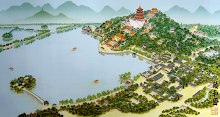The gardens that became the Summer Palace date from the Jin Dynasty (1115-1234).
Yuan Dynasty, 1279-1368:the Mongol Emperor Kublai Khan , he wanted to improve Beijing's water supply. So therefore he ordered the construction of canals to transport water from the Western Hills to the Summer Palace.Also enlarging the lake (now called KunMing Lake) to act as a reservoir.
1750: Emperor QianLong (1736-1796) of the Qing Dynasty (1644-1911) added a lot to the gardens of the Summer Palace. His appointed designers made a lot of the same designs as the rest of China. KunMing Lake was enlarged to imitate the West Lake in HangZhou.
1860: the Anglo-French Allied Forces invaded Beijing and set fire to many of the buildings within the Summer Palace.
1888: Dowager Empress CiXi, (with the funds from the Imperial Navy) restored the grand gardens. The reconstruction and enlargement of the Summer Palace continued for ten years. When they finished she renamed the gardens ''YiHeYuan'' (''Garden of Peace and Harmony'')
1889:The Empress Dowager CiXi moved her administration to the renewed YiHeYuan and the gardens that had long been an imperial "pleasureground" became finally, Summer Palace.
1900:Then, shortly after, the eight allied powers invaded during the Boxer Rebellion to plunder and destroy the newly reconstructed New Summer Palace.
1903:Only when the fugitive CiXi returned to Beijing, did full-scale restoration begin.
After the success of the 1911 Revolution: the Summer Palace was opened to the public.
Then, after the last Qing Emperor PuYi was thrown out of the Palaces in 1924: the Summer Palace was turned into a park.
1888: Dowager Empress CiXi, (with the funds from the Imperial Navy) restored the grand gardens. The reconstruction and enlargement of the Summer Palace continued for ten years. When they finished she renamed the gardens ''YiHeYuan'' (''Garden of Peace and Harmony'')
1889:The Empress Dowager CiXi moved her administration to the renewed YiHeYuan and the gardens that had long been an imperial "pleasureground" became finally, Summer Palace.
1900:Then, shortly after, the eight allied powers invaded during the Boxer Rebellion to plunder and destroy the newly reconstructed New Summer Palace.
1903:Only when the fugitive CiXi returned to Beijing, did full-scale restoration begin.
After the success of the 1911 Revolution: the Summer Palace was opened to the public.
Then, after the last Qing Emperor PuYi was thrown out of the Palaces in 1924: the Summer Palace was turned into a park.










